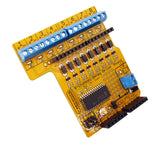With some experimenting and time it can be possible to measure the readings from digital scales with an Arduino for many reasons, including interfacing with a PC for direct data entry or further analysis, and technologist Albert from the Netherlands has done just that. By locating the analogue to digital converter used to interface the load cell in digital scales with it's own microcontroller, you can then tap into the circuit and feed the PWM data from the ADC into the Arduino's digital input pin.

Although this procedure will vary between models of scales, it's an interesting insight into hardware hacking - and if you can trace the circuit in your own scales, you're halfway there. So click here for the project page and more details. And for more, we're on twitter and Google+, so follow us for news and product updates as well.
If you're new to Arduino, the first step is a solid board for your projects - our Freetronics Eleven - the Arduino-Uno compatible with low-profile USB socket, onboard prototyping space and easy to view LEDs:




























